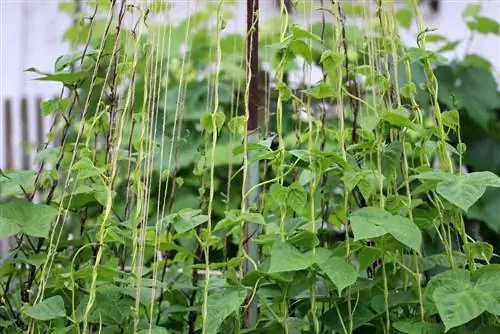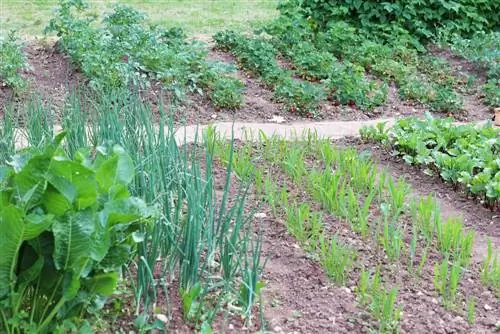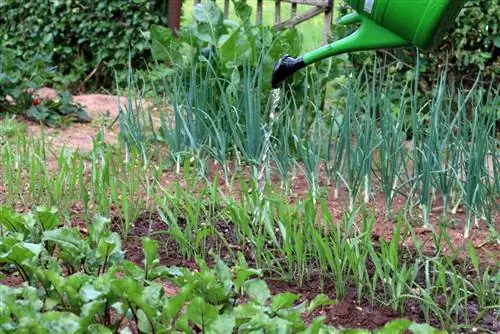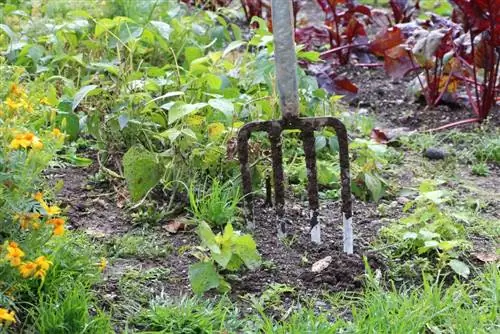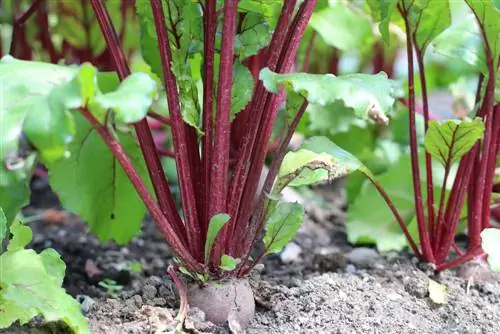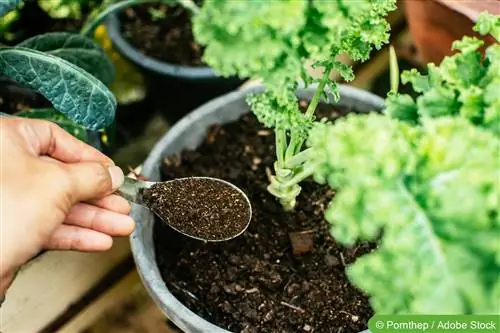- Author admin [email protected].
- Public 2023-12-17 03:39.
- Last modified 2025-06-01 06:48.
Knowing the requirements and benefits of low-eaters can help in the garden to achieve higher yields, he althier plants and more efficient use of available cultivation areas. Especially in small green areas, it is crucial to arrange them correctly in the crop rotation in order to be able to exploit all the benefits. Interested hobby gardeners can find out which plants and vegetables are weak eaters and how they should be cared for and used in the following lists and tips.
The meaning and usage
Plants are basically divided into weak, medium and heavy feeders. Occasionally, only weak and heavy feeders are differentiated, which is why a division between plants with medium and weak nutrient requirements is not always clear. The nitrogen requirements of the respective crop are mainly taken into account. This primarily determines how much they leach the soil. After growing heavy feeders such as Brussels sprouts or potatoes, large amounts of the nutrients present in the soil are used up. Without enrichment, the soil is then unsuitable for growing heavy feeders again the following year. Better than constant fertilization with large amounts of compost and manure or artificial products is a coordinated crop rotation. If the plants with high nutrient requirements become medium and then weak feeders, the substrate is naturally recovered and improved. During this time, new harvests can also be harvested.
Tip:
This proven approach, like mixed culture, not only requires less work, but is also easier on the wallet and the environment.
Claims and benefits
Weak feeders thrive particularly well on poor soils, but too many nutrients harm them. It is therefore unfavorable to plant them on a freshly fertilized bed. If cultivation takes place here, growth is usually very weak. In addition, the plants are then very susceptible to infestation by pests and diseases. It is therefore optimal to fertilize first and then grow heavy feeders. The following year, medium-feeders come onto the bed and the weak-feeders bring up the rear. The soil is then already enriched with nitrogen and other important substances, but is not yet completely suitable for heavy eaters. Fertilization is still necessary after about three years.
Herbs
Herbs are almost exclusively low-feeders and are therefore well suited for mixed crops and as crop rotation after heavy feeders. Almost all varieties that have to be re-sown every year have low nutrient requirements. These include:
- cress
- parsley
- Dill
- Basil
- Borage
- Savory
- Liebstöckl
- Thyme
- Rosemary
Chives, on the other hand, like garlic, leeks and onions, are more likely to be classified as medium-eating foods.
Vegetables and salad
Weak eaters of vegetables and salad include:
- Radish
- Beets
- Lamb lettuce and rocket
- Peas
- Bush beans, broad beans and runner beans
- Purslane
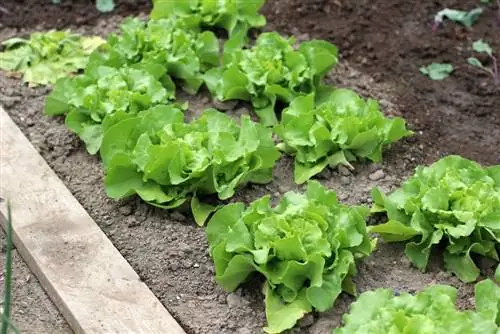
If you want to please rabbits and the like, you can also grow red clover, lupine and alfalfa. Like beans and peas, these belong to the so-called legumes and are excellent soil improvers. Middle-eaters are also quite undemanding, such as:
- Parsnips and carrots
- Black Roots
- Spinach
- Chard
- Radicchio
- Fennel
- Kohlrabi, chicory and Chinese cabbage
- Radishes
- Aubergines
- Endives
- Beetroot
Fruit
Since fruit trees and bushes - with the exception of strawberries - remain in the same growing location, they play no role in the bed as weak feeders. However, strawberries are low-eaters and can definitely be grown after plants with high nutrient requirements.
Weak-consuming plants
Some low-energy plants are not suitable for consumption, but like legumes, they can improve the soil or have beneficial effects on a mixed crop. They can keep pests away or attract beneficial insects and even reduce the risk of illness. These include:
- Tagetes or student flowers
- Stinging nettles
- Lavender
- Marigold
- Eberraute
- Tulips
- Lilies
There are also some herbs and edible plants that also have a positive impact on the closest neighbors in cultivation. These include:
- Sage
- Rosemary
- Peppermint
- Wormwood
- Chervil
- Oats
- Dill
- Basil
- garlic
- Nasturtium
- Buckwheat
- Borage
- Savory
- Horseradish
- Onions
Favorable planting neighbors and combinations
With mixed crops and the three-year crop rotation already described, it is not just the level of nutrient requirements that is crucial. The proximity of the plants and their compatibility with each other are also important factors for he althy plants and rich yields. The rule of thumb is: plants in the same family should not be in the same bed next to each other and should not be grown in the same location the following year. On the one hand, the plants could become competition for each other. Otherwise, the risk of disease outbreaks and pest infestation increases.
Good neighbors for mixed culture are:
- Eggplant: bean, lettuce and radish as well as radish
- Beans: eggplant, cabbage and lettuce, tomatoes, strawberries, cucumbers, celery, savory and beetroot
- Endives: beans, leeks and onions, cabbage, fennel
- Peas: herbs, carrots, cabbage and kohlrabi, radishes and radishes as well as zucchini
- Fennel: lettuce, cucumber, peas, endive, herbs
- Green cucumbers: beans and peas, dill, fennel, cabbage and kohlrabi, onions and leeks, lettuce, beetroot and celery
- Carrots: onions and leeks, peas and beans, radishes and radishes, tomatoes
- Potatoes: beans, spinach, cabbage and kohlrabi
- Garlic, leeks and onions: carrots, parsnips, strawberries, cucumbers, beetroot
- Cabbage and kohlrabi: peas and beans, tomatoes, radishes and radishes, onions and leeks, spinach, lettuce, celery
- Radish and radish: peas and beans, carrots and parsnips, lettuce, cabbage and kohlrabi
- Salad: peas and beans, onions and leeks, carrots, parsnips, tomatoes, cabbage and kohlrabi
- Celery: beans and peas, spinach, tomatoes, cabbage and kohlrabi
- Tomatoes: peas and beans, onions and leeks, celery, lettuce
- Zucchini: savory, parsley and other herbs, lettuce, onions and leeks, carrots, radishes and radishes, beetroot, peas and beans, celery
Optimal crop rotation
In a classic three or four-year crop rotation, heavy feeders are first grown on the specially fertilized or green manure bed. In the following years, medium and finally low feeders until the bed needs to be fertilized again. Here too, in addition to the requirements for the nutrient content of the substrate, the tolerance of the plants must also be taken into account.
Better sequences are, for example:
- Cabbage and tomatoes - cucumbers, celery, onions and leeks - savory, peas, beans and strawberries
- Potatoes - lettuce, radish, spinach - peas and beans
- Zucchini and celery or cabbage -: carrots, onions and leeks, beetroot - savory, parsley and other herbs, peas and beans
However, it is unfavorable to let plants of the same family follow each other. For example, artichokes, radicchio and salsify. But cabbage, kohlrabi, radishes and radishes as well as cress should not follow one another directly. It is worth creating a garden calendar with an overview. On the one hand, what is planted and when and where can be planned better, and on the other hand, unfavorable crop rotations can be avoided more easily.
Tips for small gardens
Knowledge of poor feeders and correct crop rotation brings high yields and significantly reduces the amount of care required. In addition, money is saved and the environment is protected, as neither frequent fertilization nor diseases and pests have to be combated - or at least this is kept to a minimum. However, this form of cultivation can quickly become boring in gardens with small acreage. The following tips will help here:
- Divide the cultivated area into three to four sections and use these for green manure or fallow land, heavy feeders, medium feeders and weak feeders. Annual rotation ensures maximum use of the soil, but does not overtax it.
- Create mixed cultures, combining plants with long and flat roots, as well as tall and short plants.
- Use raised beds and plant bags for plants that are incompatible with many others or themselves. This variant is also beneficial if you simply cannot do without some plants, but they do not fit into the current crop rotation or mixed culture.
- Interrupt cultivation areas with berry bushes, herb cuttings and lawn edges. This ensures clear boundaries and he althy mixtures - but protects the roots from competition with each other.
Conclusion
If you pay a little attention to low-eaters and suitable planting neighbors, you can achieve significantly higher yields with little effort - even on small cultivation areas. In addition, the practical effort is significantly reduced if you have the right knowledge.

